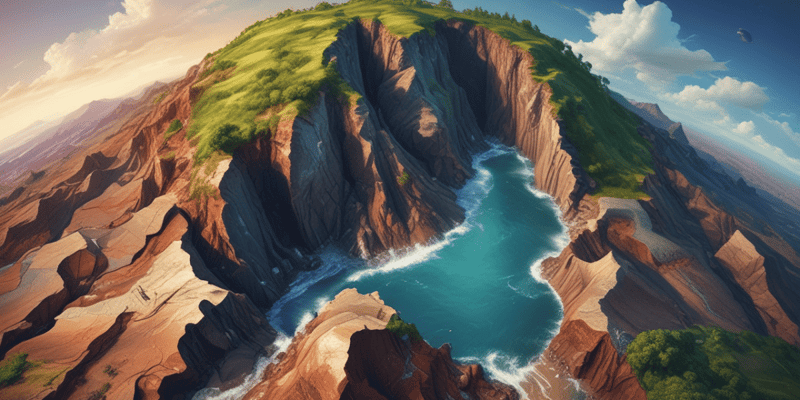32 Questions
Which seismic wave can travel through both solid and liquid layers?
P-waves
What is the composition of the oceanic crust?
Basaltic rocks
Who proposed the theory of continental drift?
Alfred Wegener
What is the driving force behind plate tectonics?
Convection currents
What is the composition of the oceanic crust?
Basaltic rocks
Which scientist proposed a mechanism for how continents move, involving convection of the mantle?
Harry Hess
What type of plate boundary is associated with shallow earthquakes in narrow belts at mid-ocean spreading centers?
Divergent plate boundary
What is another term for a passive plate boundary?
Conservative plate boundary
What primarily drives plate tectonics?
Convection of the mantle
Which type of plate boundary occurs where plates slide past each other with a strike-slip motion?
Transform
Where are metamorphic rocks typically produced?
In areas of continent-continent collision
What type of rocks make up the oceanic crust?
Basaltic rocks
What occurs at divergent plate boundaries?
Plates pull apart
What type of motion characterizes transform plate boundaries?
Strike-slip motion
What undergoes textural and mineralogical changes due to heat, pressure, and deformation?
Metamorphic rocks
Where is new lithosphere created?
At mid-ocean ridges
What type of plate boundary results in the subduction of the oceanic plate into the mantle?
Convergent
What is the weaker region of the upper mantle that deforms by viscous flow?
Asthenosphere
What type of motion characterizes the movement at mid-ocean ridges?
Divergent motion
What drives plate tectonics primarily?
Mantle convection
What type of seismic waves can travel through both solid and liquid layers of the Earth?
P-waves
What type of volcanic material tends to be found at convergent boundaries?
Silica-rich andesites
What is the primary composition of oceanic crust?
Basalt
Where is new lithosphere created through seafloor spreading?
Mid-ocean ridges
What type of plate boundaries involve the subduction of oceanic plates into the mantle?
Convergent plate boundaries
What type of rocks are produced in subduction zones due to intense heat and pressure?
Metamorphic rocks
What is the mechanical boundary between the Lithosphere and Asthenosphere called?
Lithosphere Asthenosphere Boundary (LAB)
What type of plate boundaries produce volcanic rocks, specifically basalt?
Divergent plate boundaries
What is the boundary between the Crust and the Mantle associated with a mineralogical phase change from basalt to peridotite called?
Mohorovičić Discontinuity (Moho)
What type of boundaries occur where plates slide past each other horizontally, causing faults and earthquakes?
Transform plate boundaries
What are convergent plate boundaries associated with the formation of?
Mountain belts
What type of rocks are primarily formed at divergent plate boundaries?
Volcanic rocks, specifically basalt
Study Notes
Plate Tectonics and Earth's Structure Summary
- Convergent boundaries occur where plates collide, causing faults, earthquakes, and subduction of oceanic plates into the mantle.
- Volcanic material at convergent boundaries tends to be silica-rich andesites or rhyolites.
- P-waves are the only seismic waves that can travel through both solid and liquid layers of the Earth.
- The mechanical boundary between the Lithosphere and Asthenosphere is called the Lithosphere Asthenosphere Boundary (LAB).
- Oceanic crust is primarily composed of basalt, formed from solidified lava.
- Transform plate boundaries occur where plates slide past each other horizontally, causing faults and earthquakes.
- The Moho, the boundary between the Crust and the Mantle, is associated with a mineralogical phase change from basalt to peridotite.
- Metamorphic rocks are produced in subduction zones due to intense heat and pressure.
- New lithosphere is created at mid-ocean ridges through seafloor spreading, where basalt is produced.
- Divergent plate boundaries produce volcanic rocks, specifically basalt.
- Convergent plate boundaries are associated with the formation of mountain belts, such as the Alps and Himalayas.
- Convergent plate boundaries involve the subduction of oceanic plates into the mantle.
Test your knowledge of plate tectonics and the Earth's structure with this quiz. Explore topics such as convergent and divergent boundaries, seismic waves, oceanic crust composition, and the formation of mountain belts. See how much you know about the processes that shape the Earth's surface.
Make Your Own Quizzes and Flashcards
Convert your notes into interactive study material.




